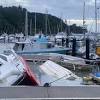How gigantic eruption’s rare ‘booms’ are informing New Zealand’s disaster planning

In 2022′s case, the pressure waves rippled from the largest and most energetic explosion ever observed: the undersea eruption of Tonga’s Hunga Tonga-Hunga Ha’apai volcano.
The waves were picked up by pressure sensors as far away as Iceland, while its low-frequency bass-like booms could be heard over thousands of kilometres between New Zealand and Alaska.
In a newly published study, GNS Science senior hazard and risk management scientist Dr Mary Anne Clive and her colleagues explored survey data from nearly 2000 Kiwis about their observations that day.
“Most volcano monitoring equipment is designed to filter out the audible-range frequencies that we can hear because these sounds, such as from trucks, cities or wind, can create noise in the data that can obscure some volcanic signals,” Clive explained.
“We were curious whether people’s observations could help expand the acoustic monitoring record to fill this gap – and we also wondered if there were any other devices in the country that recorded these audible sounds.”
The researchers found people in the North Island reported hearing more and louder booms and, being closer to the eruption, did so earlier than those in the south.
“Remarkably, some people felt the pressure wave in their chest or ears, describing a sensation similar to loud bass at a concert,” Clive said.
“There were also many observations of unusual animal behaviour and windows and buildings shaking.”
When the team compared peoples’ reports with acoustic and seismic instruments recorded, they were surprised at how well the two datasets matched up.
“Observations of the timing, loudness, and number of ‘boom’ sounds that people heard align well with the eruption signals recorded by geophysical sensors across the country.”
Clive said that match was important, given the combined recordings gave scientists wider coverage, higher resolution and broader insights about how the pressure waves swept across the country.
Not only did the observations tell scientists how these waves could impact structures – even when sent from thousands of kilometres away – but they signalled a potentially useful new tool for hazard planning.
“It suggests that human observations can serve as a reliable source of data to support more traditional high-tech volcano monitoring tools,” Clive said.
“The more data we have, the more we can work towards increasing our understanding of these volcanic processes to reduce the impacts of such devastating eruptions.”
Creating tools to collect and share crowdsourced observations of volcanic activity could ultimately help capture valuable and reliable information about changes in our volcanoes, she explained.
“One of the challenges with this is designing a tool in such a way that it ensures the safety of people making observations comes first,” Clive said.
“This eruption gave us a way to explore crowdsourcing volcanic information in the context of an event that posed minimal direct risk to Aotearoa.”
The results, just published in the journal Communications Earth and Environment, also showed how eruption sounds could serve as important cues for peoples’ behavioural response to a major event.
“Information about eruption sounds and pressure waves may therefore be useful to include in messages about natural warnings.”
Clive pointed out New Zealand already has some crowd-sourcing tools in action: after last month’s 5.7 shake near Wellington, for instance, more than 37,000 people contributed to GeoNet’s “Felt Rapid” reports.
GNS recently widened that survey tool to enable people to provide reports about damage and how they’d responded to the earthquake – all of which have helped add more detail to GeoNet’s new “shaking layers” maps.
Jamie Morton is a specialist in science and environmental reporting. He joined the Herald in 2011 and writes about everything from conservation and climate change to natural hazards and new technology.
Sign up to The Daily H, a free newsletter curated by our editors and delivered straight to your inbox every weekday.


 New Zealand
New Zealand Argentina
Argentina  Australia
Australia  Austria
Austria  Brazil
Brazil  Canada
Canada  Germany
Germany  Ireland
Ireland  Italy
Italy  Malaysia
Malaysia  Mexico
Mexico  Poland
Poland  South Africa
South Africa  United Kingdom
United Kingdom  United States
United States 











